Moong Dal recipe is a delicious, healthy and protein rich dish made from hulled and split mung beans or yellow moong lentils. Here I share two different recipes that feature tasty lentils: Moong Dal Tadka, with flavorful seasonings tempered in hot oil or ghee, and Moong Dal Fry, which includes lightly sautéing aromatics before mixing with the cooked yellow mung lentils. Both methods are easy to prepare with my step-by-step instructions and photos, and create incredibly savory, satisfying lentil dishes!
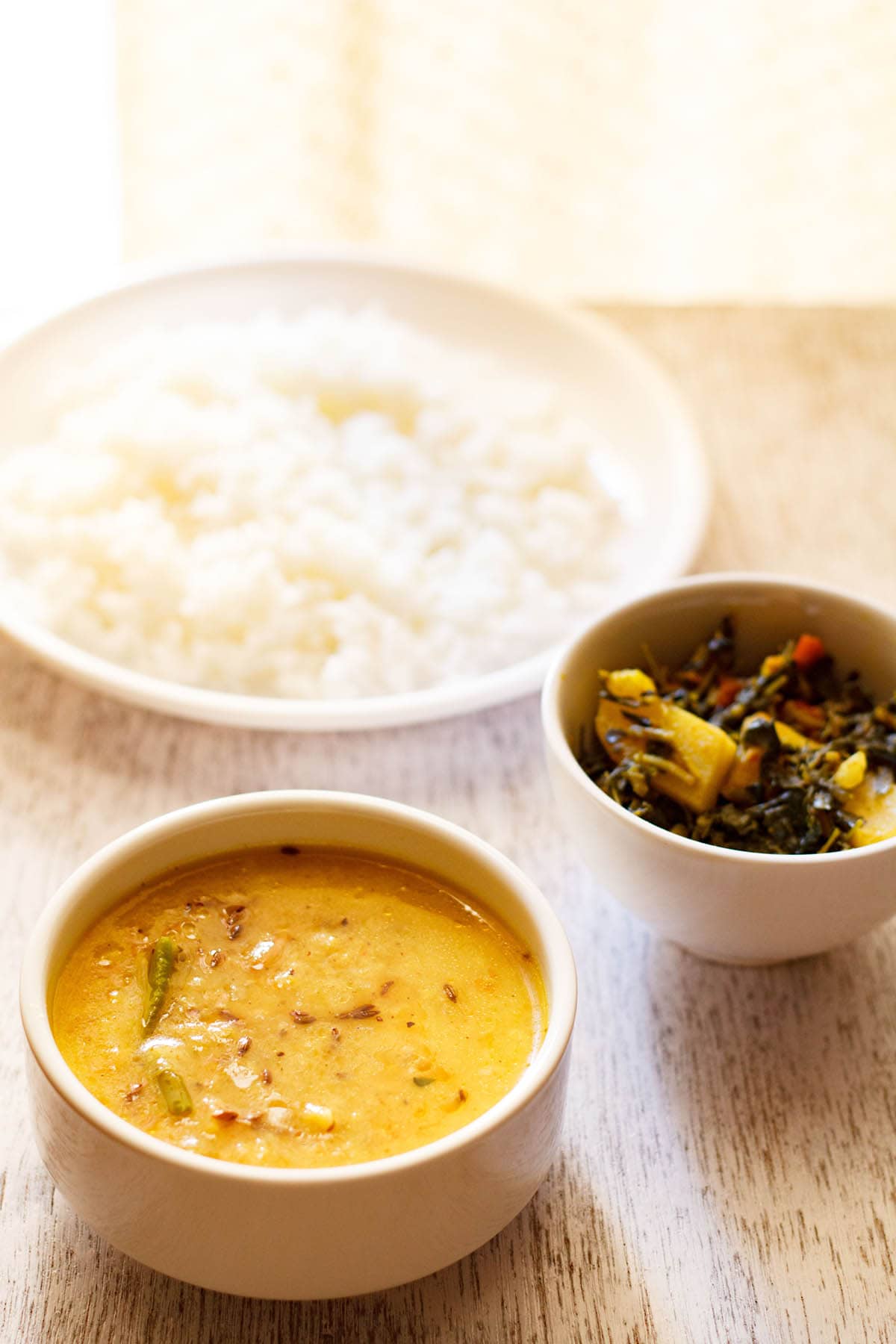
What is Moong Dal
Lentils, and mung beans in particular, are a staple in Indian cuisine. They are commonly pressure cooked to become wonderfully tender, and served as saucy main dishes with roti, paratha or steamed rice.
Moong dal here refers to skinned and split mung beans also known as petite yellow lentils. They originally are greenish in color, but have a yellow color once the husks are removed.
Photo of hulled and split mung lentils below.
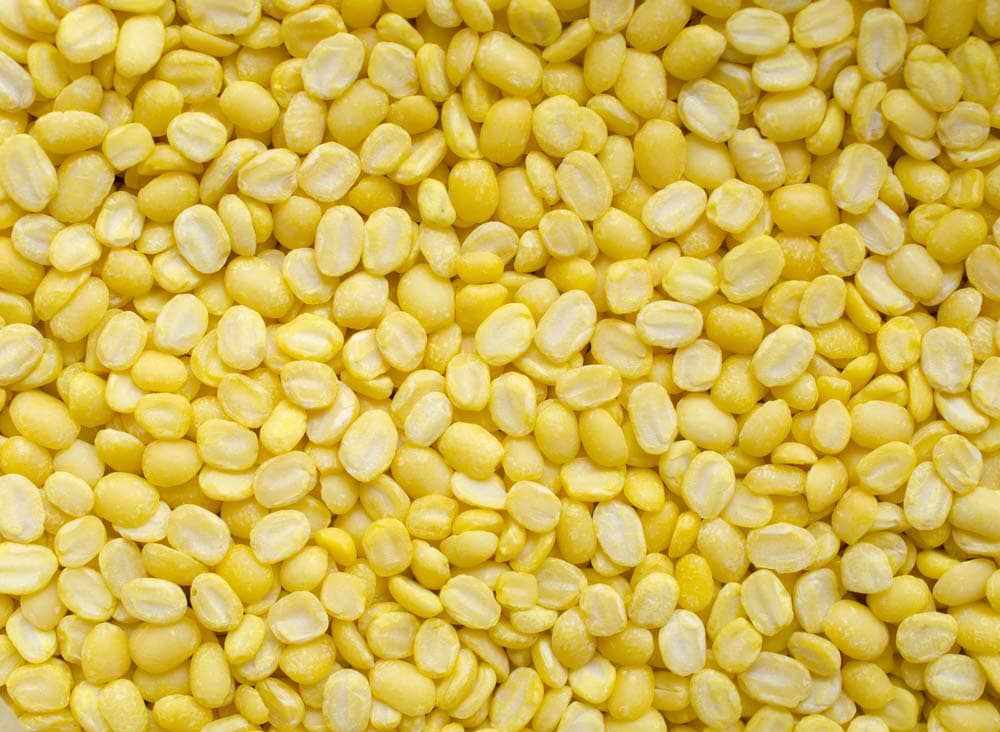
On the other hand, a dal recipe is also referred to as Dal and so this preparation made with mung lentils is also called Moong Dal.
Compared to other lentils, Moong lentils are among the easiest to digest. Therefore they are often recommended for low glycemic diets, and are a part of the detox diet in Ayurveda.
Dishes with mung beans are thought to balance the Kapha, Pita and Vata doshas in the body, and thus are tridoshic in nature as per Ayurveda.
If you are like moong lentils, than you can also check out this tasty recipe made with green gram or whole moong lentils – Green Moong Dal
Table of Contents
About Moong Dal Tadka
‘Tadka’ here refers to the cooking method used to make this recipe: It is called tempering in English, and no, it’s not in any way related to tempering chocolate. In this method, the spices and herbs are first fried in oil or ghee (clarified butter).
Basically it is blooming of spices in fat. Frying them releases their essential aroma and flavors into the oil.
After being fried, this entire infusion of the spices, herbs and the oil is added to the completed cooked moong dal.
Sometimes moong dal recipes can lack flavor. However, as I’m sure you can imagine this dish is absolutely bursting with bold, savory spices.
It includes tempered cumin, garlic, garam masala and red chili powder. Together they create a rich, earthy, wonderfully tasty dish.
Once you make this delicious moong dal recipe, you are going to have a whole new opinion of the humble dal!
The consistency of Moong Dal Tadka is somewhere between a curry and soup, slightly thin and pourable but still with a good bit of body.
It’s perfect to serve with some steamed basmati rice and a side vegetable dish and/or raita. And I always recommend that you have some roasted papad and lemon or mango pickle on the side, too, for a complete meal.
I love to pair moong dal tadka with some steamed basmati rice and Aloo Methi.
How to make Moong Dal Tadka
Recipe 1
Prep
1. First, rinse ½ a cup of moong dal (split husked mung lentils) in water a couple of times. Drain all the water and set aside.
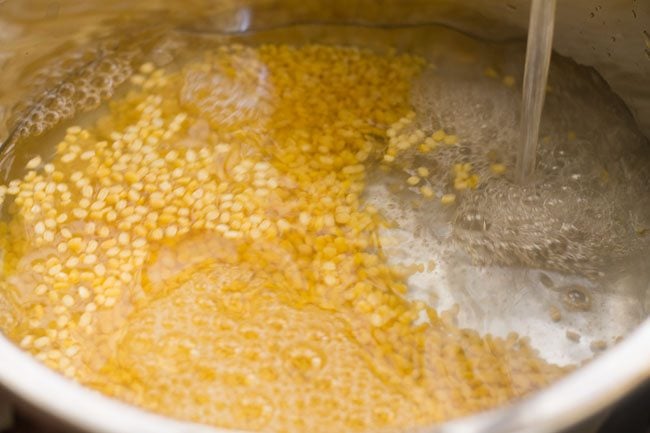
2. You will need to cook the moong lentils. In a 3 litre stove-top pressure cooker or in the inner pot of a 6 quart Instant Pot add the following ingredients together with the rinsed moong lentils:
- 1 medium sized finely chopped onion or ⅓ cup finely chopped onions
- 1 medium sized chopped tomato or ½ cup chopped tomatoes
- 1 inch of peeled and finely chopped ginger
- ⅓ teaspoon turmeric powder
- ¼ teaspoon of red chili powder or cayenne pepper
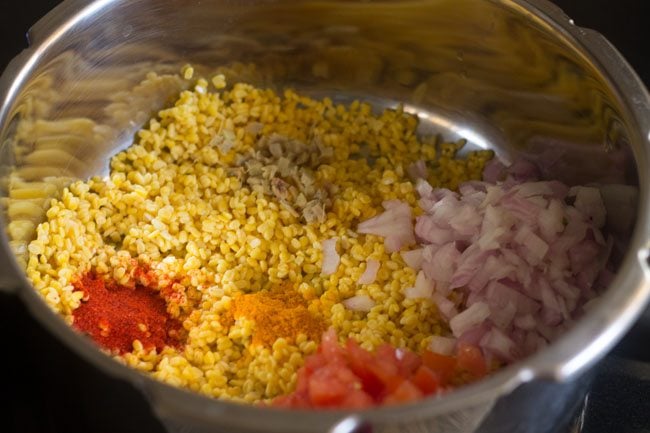
3. Add 1.5 cups of water, and stir well.
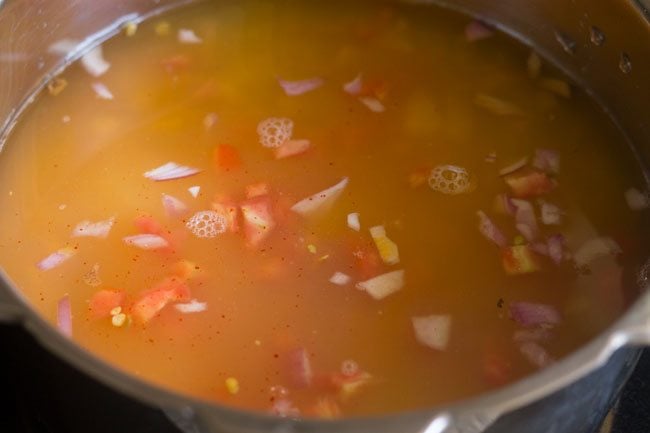
Pressure Cook Lentils
4. Pressure cook the lentils, aromatics, spices and herbs for 5 to 6 whistles on medium heat, until the lentils are cooked perfectly and softened.
Let the pressure fall naturally in the stove-top cooker and then only open the lid. Remove the lid and stir the dal.
For the Instant Pot, this will take approximately 8 to 10 minutes on manual pressure. Once you hear the beep sound when the cooking is complete, do a quick pressure release after 10 minutes.
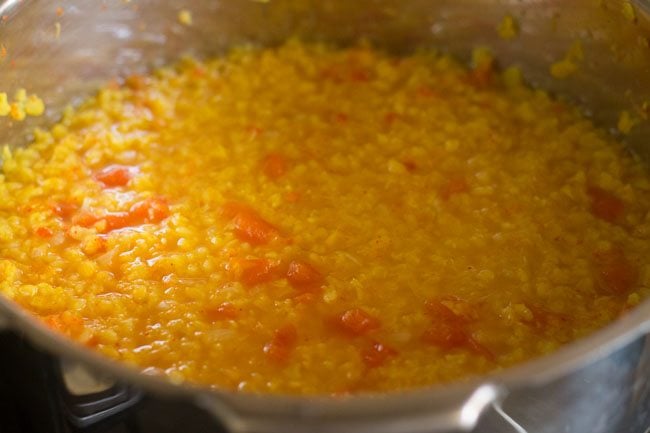
5. The dal should be loose with a medium flowing consistency. If the moong dal looks thick, then add some water. Start with half a cup and stir, and add more water as needed.
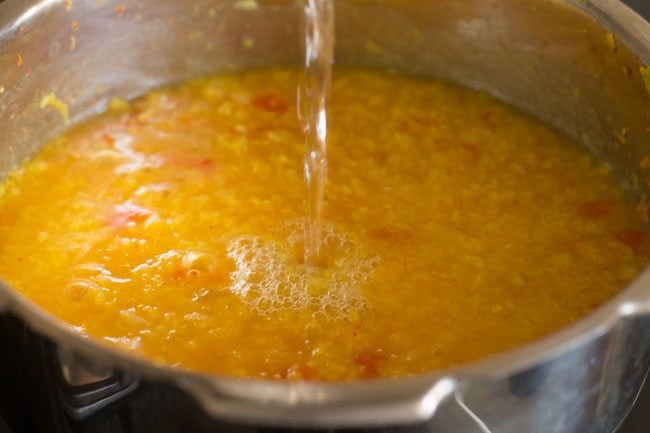
6. Simmer (or use the sauté function on the IP) the moong dal for 1 to 2 minutes or more until you get just the right consistency. It should have a consistency some where like that of a curry.
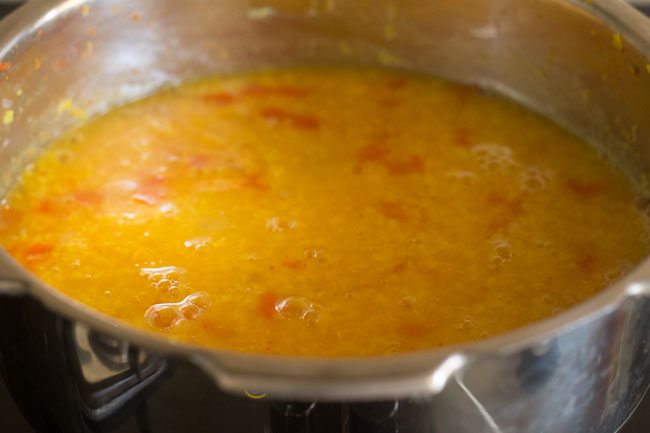
7. Add salt to taste and mix well. Set the dal aside.
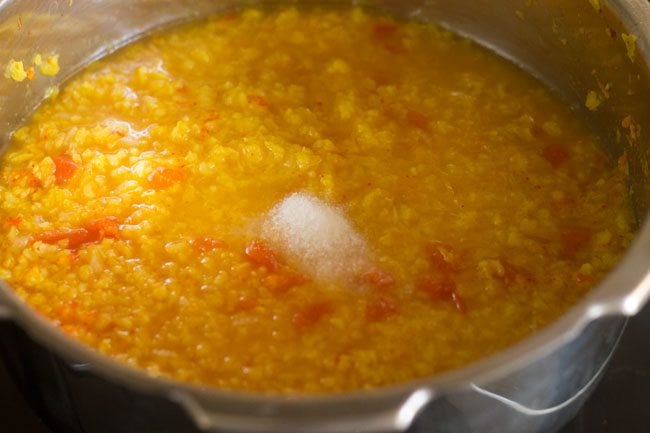
Make Tadka
8. Gather and measure all of your ingredients needed to temper the cooked moong dal. In a small pan on low-medium heat, melt 2 to 3 tablespoons of oil, ghee or butter.
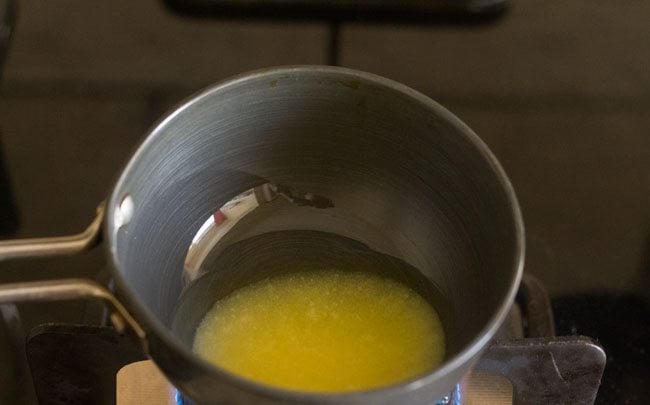
9. Fry 1 teaspoon of cumin seeds in the hot oil. They should change color and crackle, but not burn. Turn the heat down to low if needed.
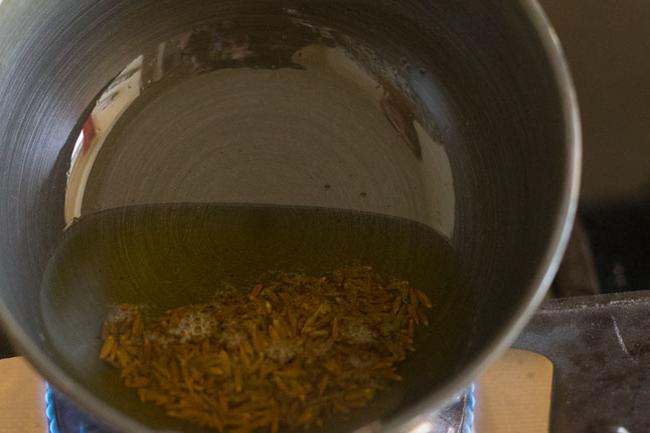
10. Next add 4 to 5 lightly crushed garlic cloves and 1 to 2 slit green chilies to the pot. Fry for a few seconds, but don’t brown the garlic. Turn off the stovetop heat immediately.
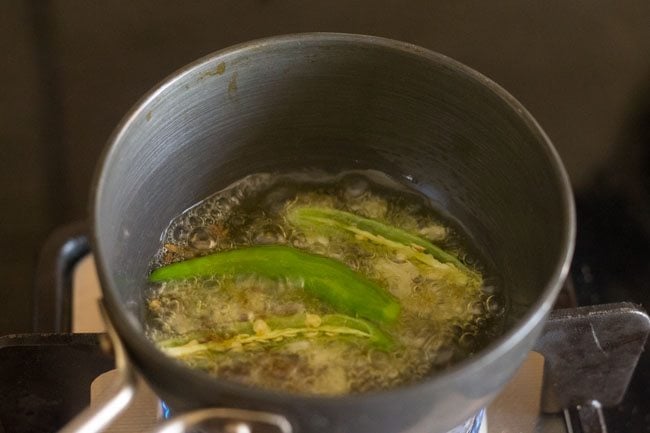
11. Once the heat is off, add ¼ to ½ teaspoon of garam masala powder, ¼ teaspoon of red chili powder and 1 pinch of asafoetida (hing).
Switching off the heat ensures that the spice powders don’t get burned.
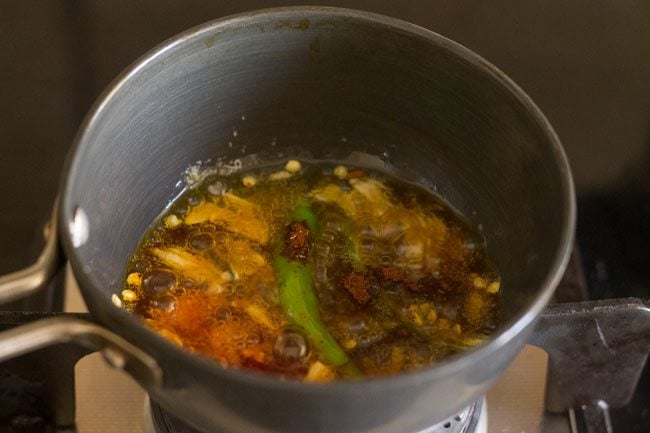
12. Quickly mix the spice powders well with a spoon. This is your tempering mixture to add flavor to the moong dal.
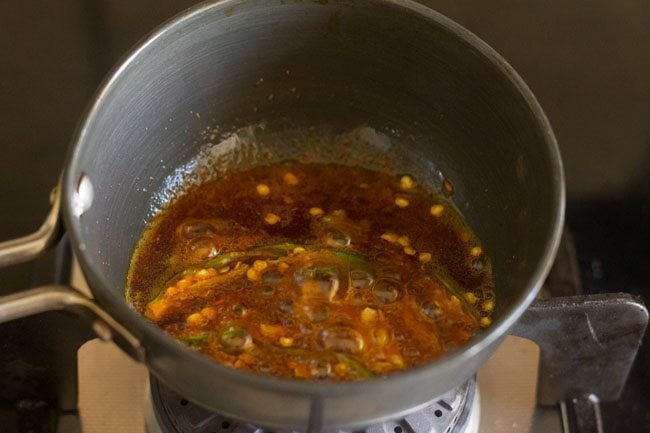
13. After stirring, immediately pour the tempering mixture into the pot with the cooked lentils. Stir the moong dal tadka well to combine.
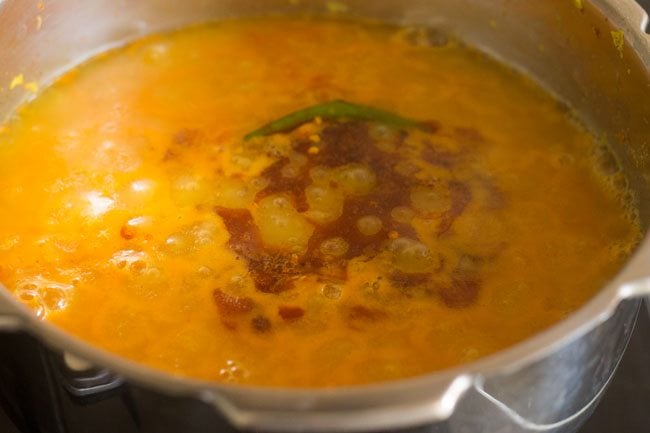
14. Serve Moong Dal Tadka hot with steamed rice or Roti. The moong dal tastes delicious as-is with no need to garnish.
But feel free to sprinkle with some chopped coriander leaves to add a pop of fresh flavor.
For a slight tang of bright acidity, you can also squeeze some lemon juice onto the dish before serving.
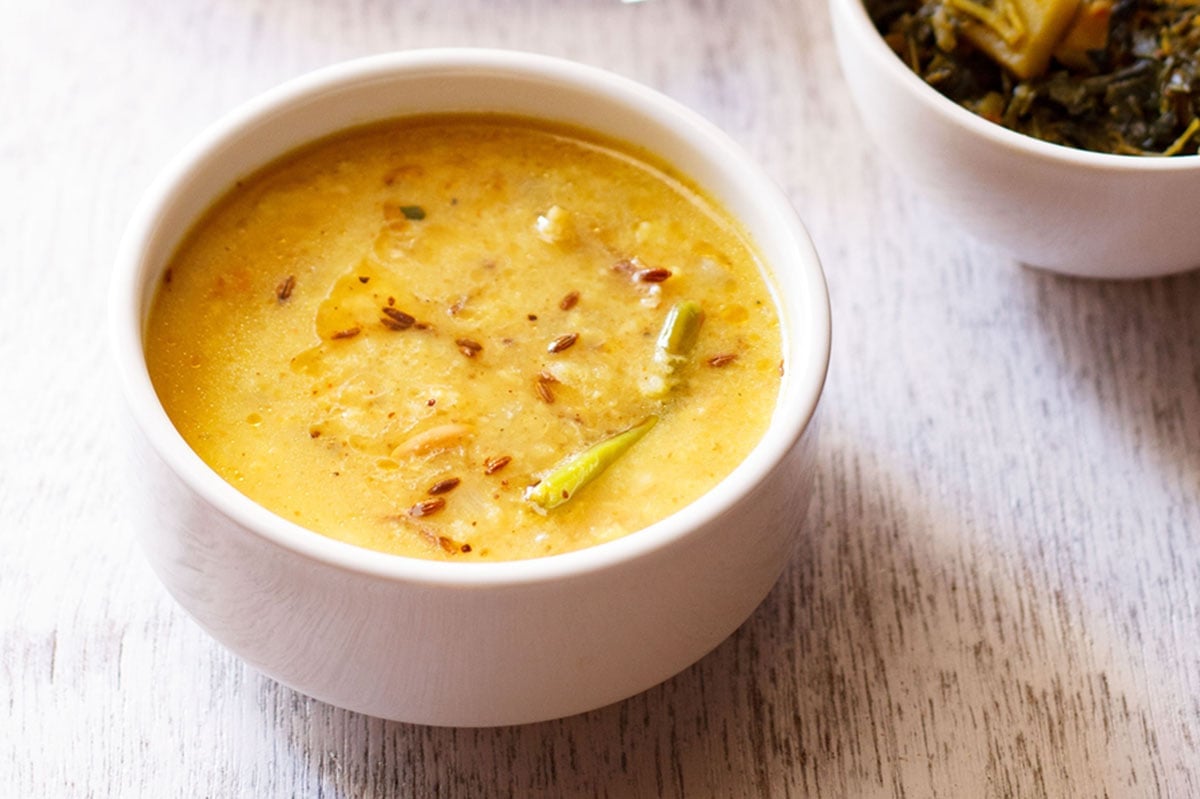
About Mung Dal Fry
This is a quick and easy Punjabi recipe of delicious moong dal fry at home which I often make. I make a variety of lentils on a daily basis and mung dal happens to be one of them.
In this Moong dal fry recipe, the mung lentils are cooked first. Then a sautéed mixture of onions, tomatoes and spices is added to the cooked mung lentils which is then simmered for some more minutes. The end result is a smooth, creamy and flavorful moong dal.
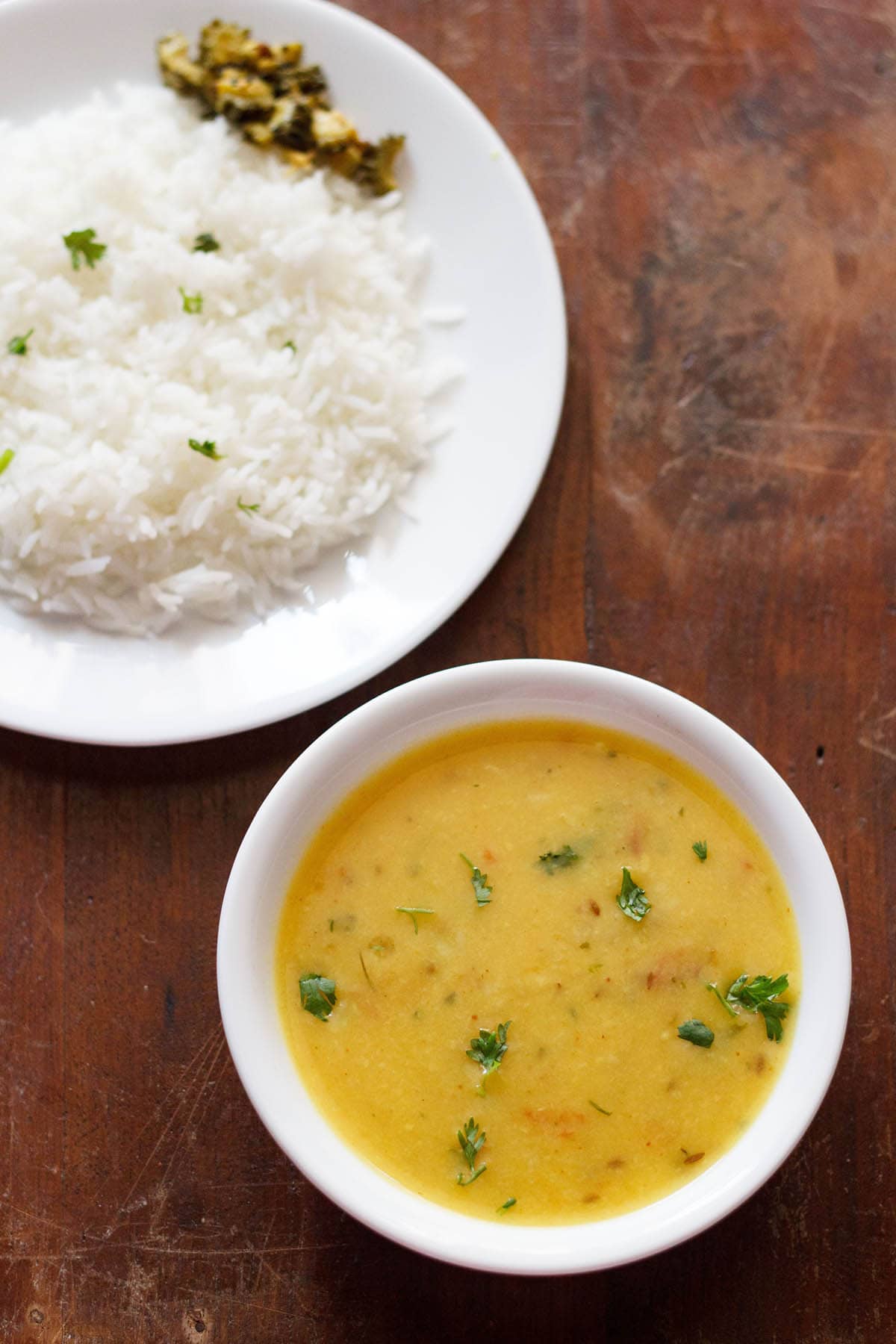
Legumes or dal are a staple in the Indian Cuisine and there are so many ways of making them. In the Indian Cuisine, you will find many variations of dal – from the simplest basic version made with minimal ingredients to spicy or rich versions made with many ingredients.
Each Indian state has their own versions of a dal tadka or dal fry. In the state itself, the versions keep on changing in some cities or towns.
You can serve the yellow moong dal fry with Indian flat breads like roti, paratha or with cumin rice or steamed basmati rice.
How to make Mung Dal Fry
Recipe 2
Cook Mung Dal
1. Firstly pick and rinse ½ cup moong dal (split and hulled mung lentils) for a few times with water. You can also rinse the yellow moong dal in a colander.
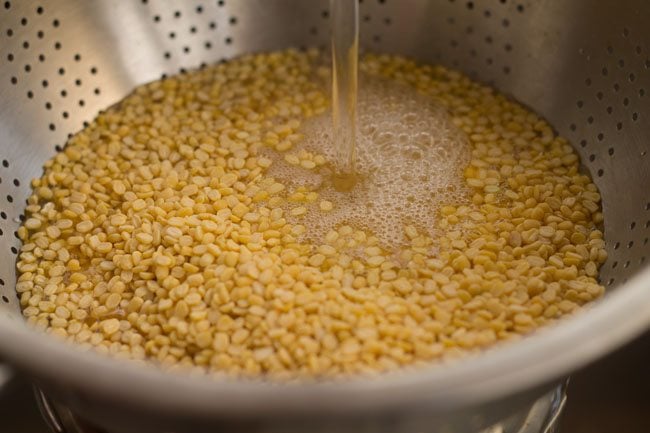
2. Then add the yellow mung lentils to a 3 litre stove-top pressure cooker together with 2.5 cups of water and a pinch of turmeric powder. Stir and mix very well.
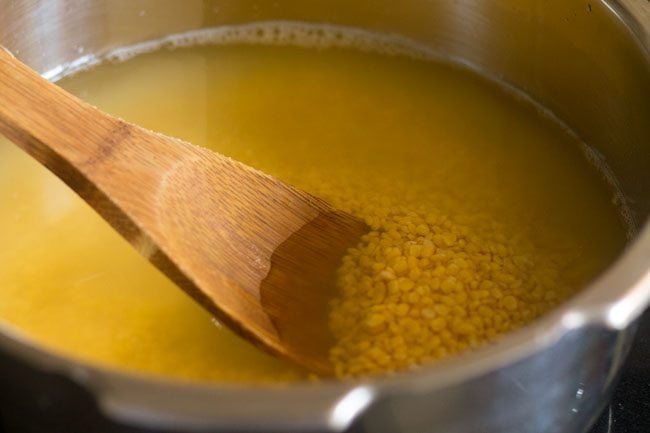
3. Pressure cook the yellow moong dal for 5 to 6 whistles or till they are soft and mushy.
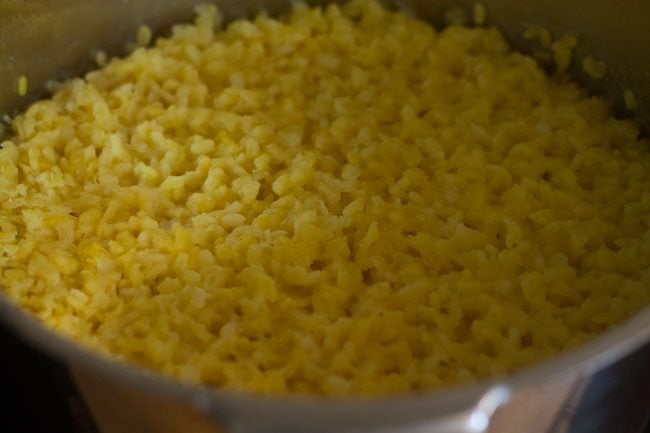
4. Mash the lentils with a spoon.
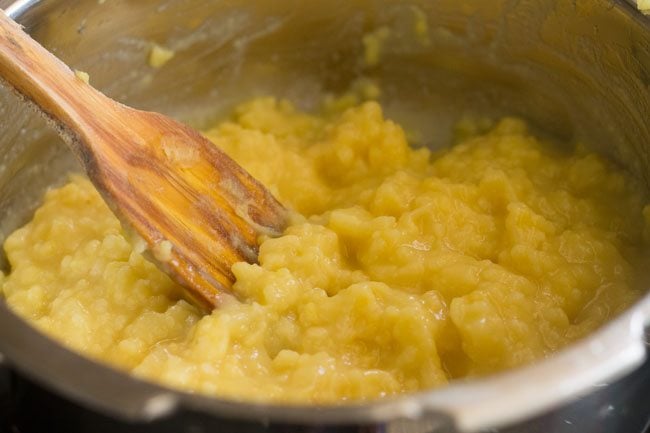
5. Add 1 cup water or as required, to get the desired consistency.
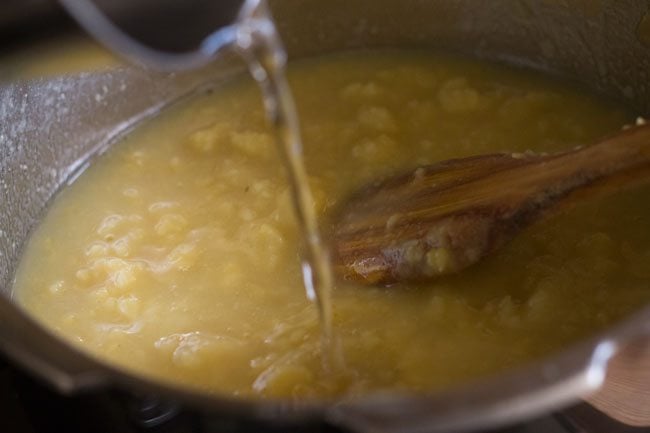
6. Add salt as required and mix again.
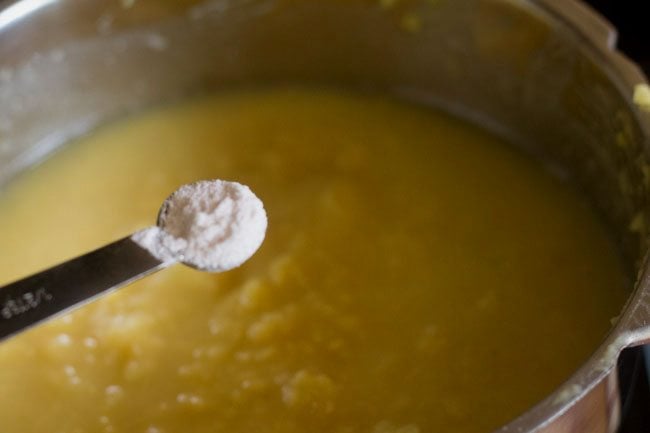
7. On a low heat, keep the cooked yellow moong dal to simmer. Remember to stir often so that the lentils does not get browned or burnt or stick to the bottom of the cooker.
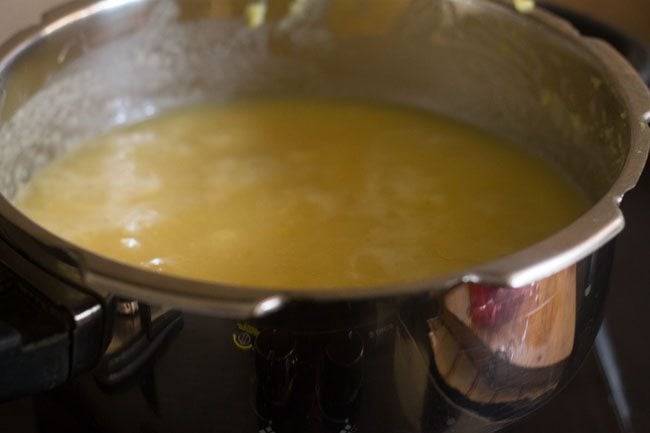
Make Moong Dal Fry
8. Meanwhile, measure and keep all the ingredients ready. In a kadai or pan, heat 2 tablespoons oil together with ½ tablespoon butter.
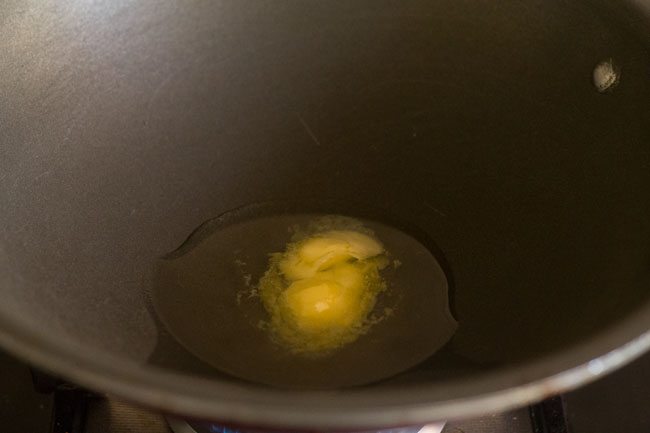
9. Crackle 1 teaspoon cumin seeds first.
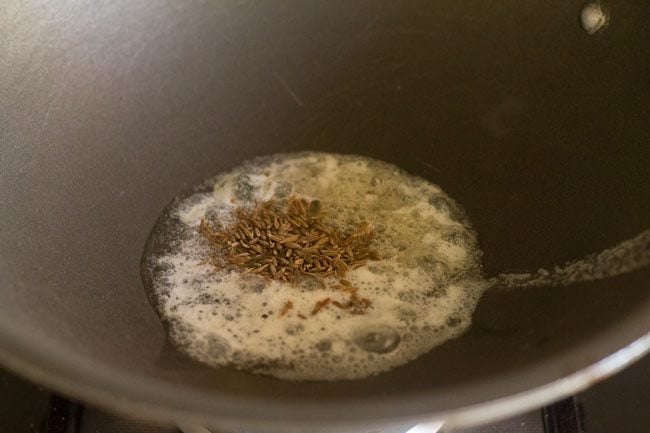
10. Then add 1 medium sized chopped onion (about ⅓ cup chopped onions). Sauté the onions till light brown. Stir often when sautéing onions.
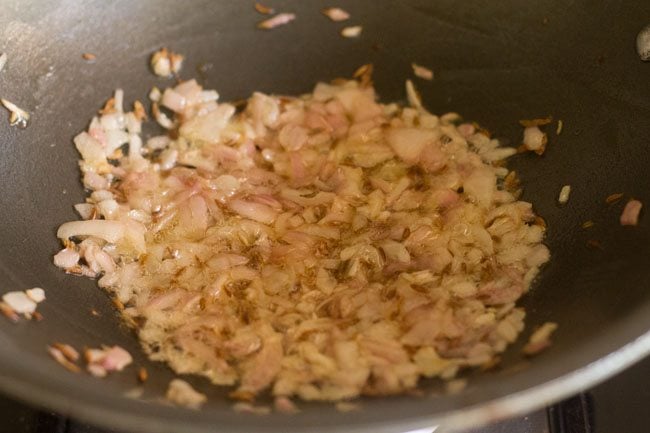
11. Then add 1 inch chopped ginger, 3 to 4 chopped small to medium garlic cloves, 1 green chili and 1 dry red chili (seeds removed). Sauté for half a minute.
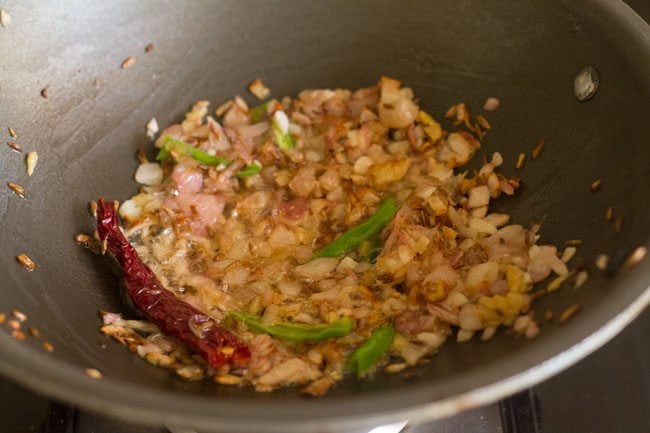
12. Add 1 medium sized tomato which has been chopped (about ½ cup chopped tomatoes). Sauté stirring often until the tomatoes soften.
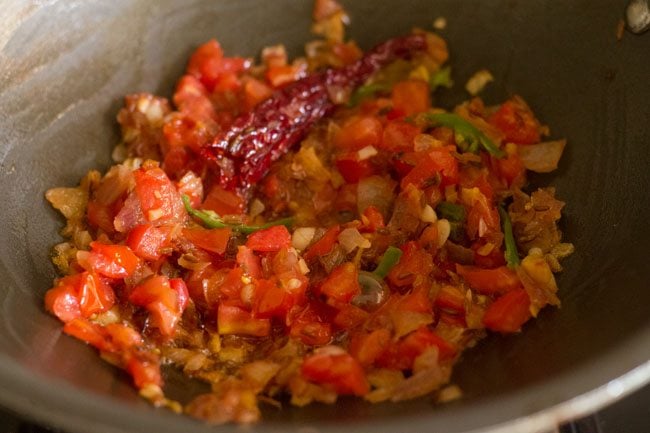
13. Then add the following spices and stir to combine:
- ¼ teaspoon red chili powder or cayenne pepper
- ¼ teaspoon garam masala powder
- ¼ teaspoon turmeric powder
- 1 pinch of asafoetida (hing)
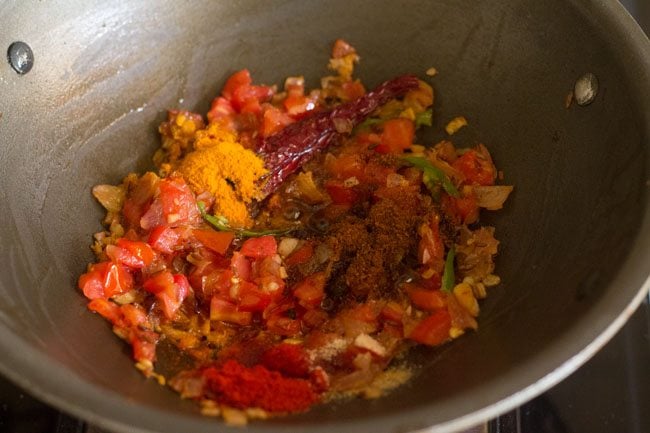
14. Next add ½ teaspoon crushed dried fenugreek leaves (kasuri methi) and 1 tablespoon chopped coriander leaves.
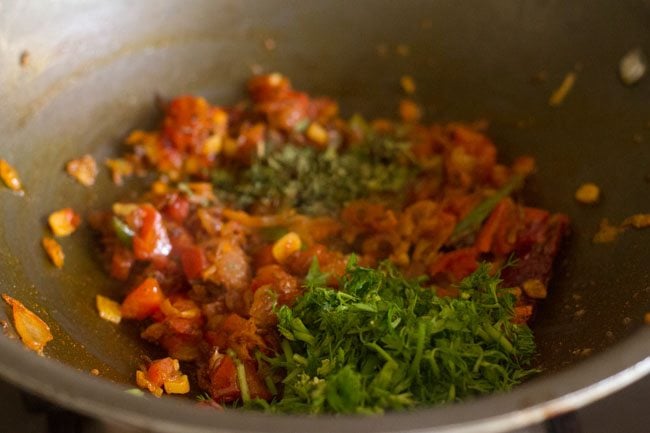
15. Stir and continue to sauté till oil starts to leave the sides of the masala. And later continue to sauté further for 1 to 2 minutes more after oil has started to leave the sides.
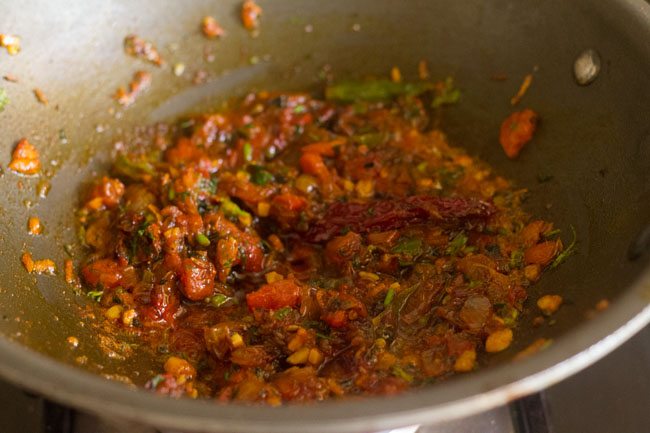
16. Add this mixture to the simmering dal.
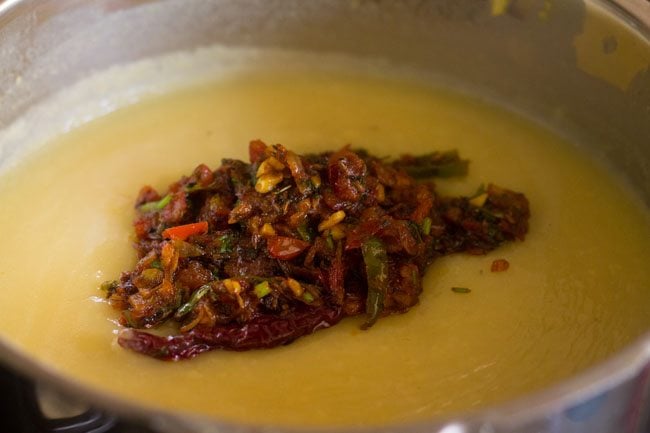
17. Stir and simmer the dal for 2 to 3 minutes or more. You have to simmer till the flavors have blended well in the moong dal and you get the desired consistency.
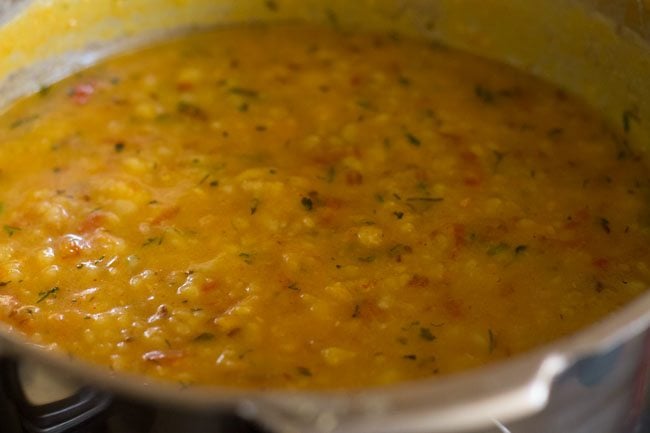
18. If you prefer you can add a few drops of lemon juice.
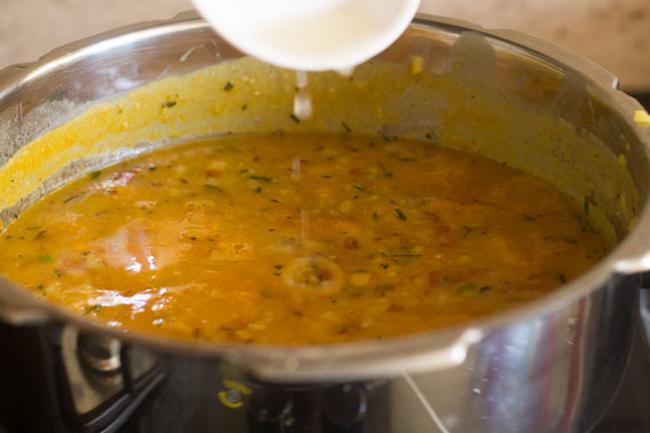
19. Mix well. Taste the dal and add salt if required. Turn off the heat. Garnish with coriander leaves.
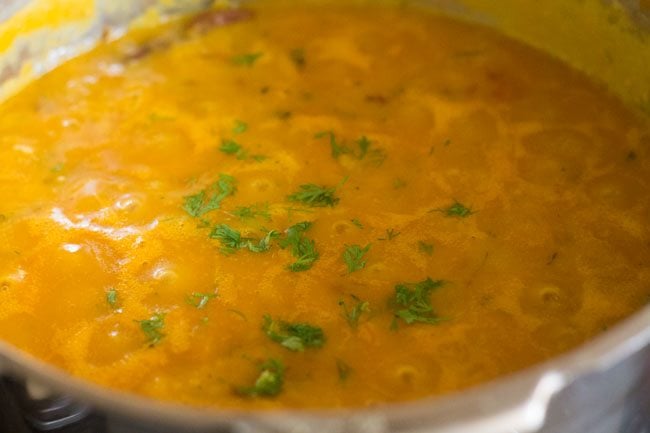
20. Serve Moong Dal Fry with steamed rice, cumin rice or with Indian flatbreads like roti, paratha or naan.
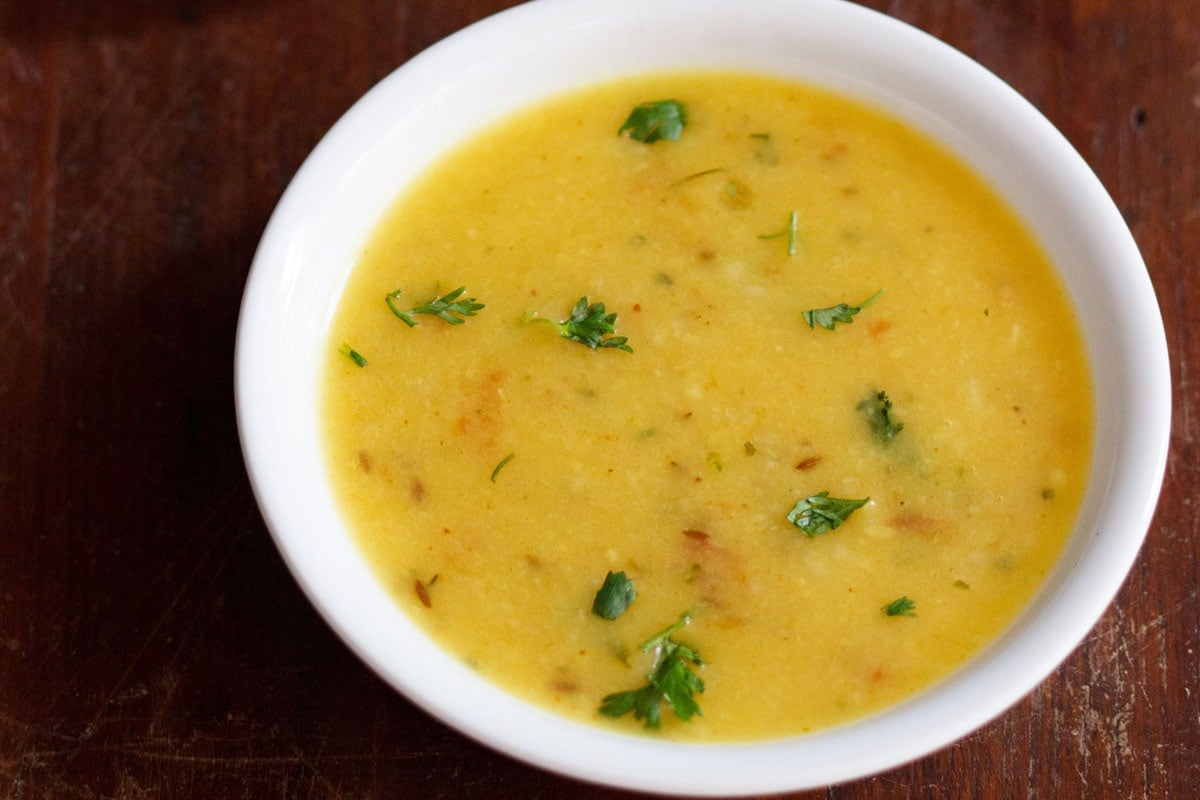
Difference between Tadka and Fry Methods
Though both the tadka and fry versions may look the same, preparation methods and the final taste of each dish is quite unique and different.
- Moong dal tadka has the lentils cooked first with aromatics. Later the spices are bloomed in fat for their flavors and aroma to release. This blooming of spices is called as tadka, chaunk, vaghar in Indian languages. This tempering mixture is mixed with the cooked moong dal which perks up the flavors more.
- Moong dal fry has the only the lentils cooked first. A sautéed mixture of onions, tomatoes, spices and herbs is added to the cooked lentils and further simmered for a few minutes. Though the word ‘fry’ is used, keep in mind that nothing is literally fried in the recipe.
Expert Tips
- While cooking any lentil dish, I suggest to use unpolished lentils for optimum flavor and nutrition.
- If you prefer you can soak the moong lentils for 20 to 30 minutes. Soaking them will reduce the cooking time.
- Either of the recipe can be turned into a one pot cooking method and can be made in a stove-top pressure cooker or Instant pot. Simply sauté the spices, aromatics first, add the lentils and water as needed. Pressure cook until done.
- Feel free to reduce or increase the pungent spices and herbs like red chilli powder, ginger, garlic and green chilies according to your taste buds.
- Make sure to cook the lentils until they are softened and mushy. You can also adjust the consistency by adding less or more water.
- For a gluten-free moong dal recipe, omit adding the asafoetida.
FAQs
If you do not have a pressure cooker at home, then you can cook the lentils along with other ingredients in a pot or pan on a stovetop.
Make sure to cover the pot or pan. Also, add water as required. Before cooking the lentils, you can also soak them for about 30 minutes.
Yes, you can definitely do so.
Of course, you can add kasuri methi in this recipe. It will only make the dish even more fragrant and delicious.
If you add salt while pressure cooking any dal or lentil, it will not become soft and mushy. The grains will get cooked but will retain their individual shape.
This is good if you want a dal recipe where the grains are visible. But in this recipe, we require a mashable consistency. Hence, adding salt while pressure cooking the dal is not suggested.
To get the proper flavor of the tadka in the dal, add the tadka and immediately close the pan or cooker with lid for a few minutes. This way, aroma and flavor of the tadka will infuse well in the dal.
More Indian Lentil Recipes To Try!
Dal (Lentils) & Legumes
Dal (Lentils) & Legumes
Dal (Lentils) & Legumes
Dal (Lentils) & Legumes
Please be sure to rate the recipe in the recipe card or leave a comment below if you have made it. For more vegetarian inspirations, Sign Up for my emails or follow me on Instagram, Youtube, Facebook, Pinterest or Twitter.
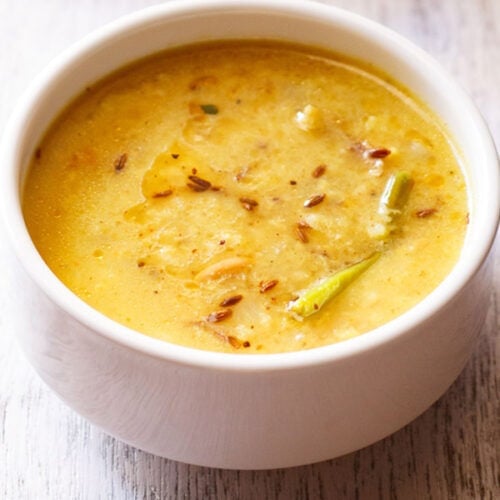
Moong Dal Recipe (Wholesome & Nutritious)
Ingredients
For Moong Dal Tadka – Recipe 1
- ½ cup moong dal (split and hulled mung lentils)
- ⅓ cup onions – finely chopped
- ½ cup tomatoes – chopped
- 1 inch ginger – finely chopped or minced
- ¼ teaspoon red chili powder or ¼ teaspoon cayenne pepper
- ⅓ teaspoon turmeric powder (ground turmeric)
- 1.5 cups water – for pressure cooking
- salt as required
For Tempering (Tadka) – Recipe 1
- 2 to 3 tablespoons Ghee or oil or butter
- 1 teaspoon cumin seeds
- 4 to 5 garlic cloves – small to medium-sized, crushed lightly
- ¼ or ½ teaspoon Garam Masala
- ¼ teaspoon red chilli powder or ¼ teaspoon cayenne pepper
- 1 or 2 green chilli – slit or ½ teaspoon chopped
- 1 pinch asafoetida (hing), optional
For Moong Dal Fry – Recipe 2
- ½ cup moong dal (split yellow mung lentils)
- 1.5 cups water – for pressure cooking. check point no 6 in notes below on cooking the lentils in a pan or pot
- 1 pinch turmeric powder
- 1 cup water – to be added later when the dal is simmering or add as the consistency required
- 2 tablespoons oil
- ½ tablespoon Butter
- 1 teaspoon cumin seeds
- ⅓ cup onions – finely chopped
- 1 inch ginger – finely chopped
- 3 to 4 garlic cloves – small to medium, finely chopped
- 1 green chili – slit or chopped or ½ teaspoon chopped
- 1 dry red chili – stem and seeds removed
- ½ cup tomatoes – finely chopped
- ¼ teaspoon red chili powder or cayenne pepper
- ¼ teaspoon Garam Masala
- ¼ teaspoon turmeric powder
- 1 pinch asafoetida (hing), optional
- ½ teaspoon dried fenugreek leaves (kasuri methi), crushed
- 1 tablespoon coriander leaves – chopped
- salt as required
- 4 to 5 drops lemon juice or as needed, optional
- 1 to 2 tablespoons coriander leaves – chopped, for garnish
Instructions
Making Moong Dal Tadka – Recipe 1
- First rinse the moong lentils a couple of times in water. Drain the water and set the lentils aside.
- In a 3 litre stove-top pressure cooker take the rinsed lentils, chopped onions, chopped tomatoes and finely chopped ginger. Also add the turmeric powder, red chili powder and water to the cooker. Mix well.
- Pressure cook for 5 to 6 whistles on medium flame till the moong lentils are softened well. Once the pressure settles down, remove the lid and stir the dal.
- If the dal looks thick, then add some water and simmer for 1 to 2 minutes.
- Add salt. Mix very well and keep aside. Check the taste and if required you can add more salt.
- In a small pan, heat oil or ghee or butter. First fry the cumin seeds.
- Next add the garlic and green chili and fry for some seconds. Don't brown the garlic. Switch off the flame.
- Now add the garam masala powder, red chili powder and asafoetida. Switching off the flame earlier ensures that the spice powders don't get burned.
- Quickly stir and immediately pour the tempering mixture in the dal.
- Stir the dal and serve hot moong dal with steamed rice or chapatis.
- The moong dal tadka tastes better as it is and there is no need to garnish or add coriander leaves to it. But if you want you can always garnish with some coriander leaves. For a slight tang you can also squeeze some lemon juice.
Making Moong Dal Fry – Recipe 2
- Pick and rinse the mung lentils first for a few times in water.
- Then add the lentils in a 3 litre stove-top pressure cooker along with water and turmeric powder. Stir and pressure cook the lentils for 5 to 6 whistles till the dal is soft and mushy.
- Mash the moong dal with a spoon.Stir in some salt and add water as required to get the desired consistency. Keep the dal to simmer on a low flame.
- Heat oil along with the butter on a low heat. Crackle the cumin seeds first.
- Add onions and fry till light brown.Now add the ginger, garlic, green chilies & dry red chili. Sauté for half a minute.
- Add the tomatoes and sauté till the tomatoes soften.Add all the red chili powder, garam masala powder, turmeric powder, asafoetida, kasuri methi and coriander leaves.
- Stir and continue to sauté till oil starts to leave the sides of the masala. Continue to sauté for 1 to 2 minutes more after oil has started to leave the sides.
- Add this mixture to the simmering dal. Stir and simmer the dal for 2 to 3 minutes or more till the flavors have well blended in the dal and till you get the desired consistency.
- If you prefer you can add a few drops of lemon juice to the dal. Serve Moong Dal Fry garnished with coriander leaves with steamed rice, cumin rice or even chapati.
Video
Notes
- Soaking: You can soak the lentils for 20 to 30 minutes and this will speed up the cooking time.
- Green Chillies: You can use serrano peppers instead of the Indian green chillies. You can even replace the green chillies with dried red chillies.
- Consistency: You can have a thick or medium or thin consistency of the dal by adding less water or more water later.
- Asafoetida: If you do not have asafoetida, skip it. For a gluten-free moong dal skip adding asafoetida.
- Spicing: You can decrease or increase the herbs & spices like red chilli powder, green chillies, garlic, ginger, cumin seeds according to your preferences. But do not increase the amount of turmeric powder.
- To cook moong lentils in a pot or pan:
– Soak the lentils in water for about 30 to 40 minutes. Then drain them and add in a pot.
– Add about 2 cups of water. Cover and let the lentils cook till done.
– If the mung lentils begin to froth, then remove the scum and continue to cook without a lid or the lid partly covered.
– You can also add a few drops of oil to reduce the frothing.
- Note that the approximate nutrition info is for 1 serving of moong dal tadka.
Nutrition Info (Approximate Values)
This Moong Dal recipe from the archives was first published in May 2013. It has been updated and republished on June 2023.
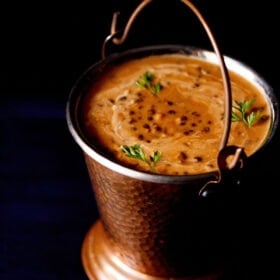
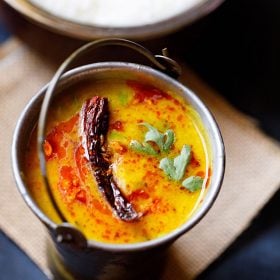
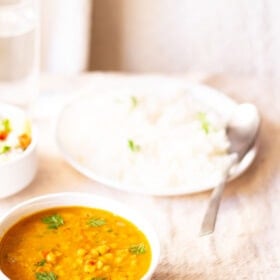
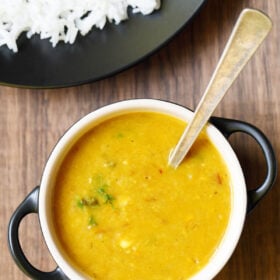
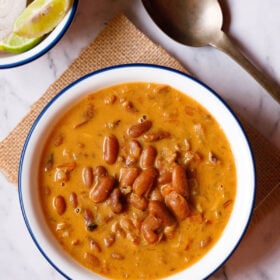
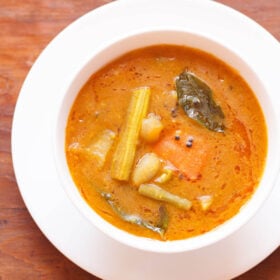








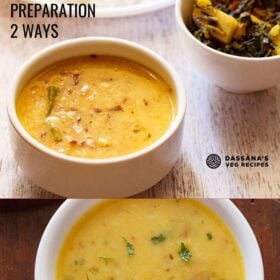
Can I make Moong Dal without a pressure cooker?
Yes you could make moong dal without the pressure cooker but that would take a longer time to cook the lentils. Hope this help’s you.
Very awesome dish in a very less time.
It has become a daily routine for me to visit your website
thankyou sonia 🙂 pleased to know this.
Hi Dassana,
You are my life line. Every day I refer to your websites for recipes even though I know how to prefer a particular dish. I am a big foodie and love the way to describe each and every step and the quantities you mention are just perfect. Even my sister who prepare lovely food refers to your website. Thanks a ton for making life of many of us easier and tastier. God bless you
we are very pleased to know this nandini 🙂 thankyou for your kind and encouraging words god bless you and you sister.
Hi dasanna,
All your recipes are fantastic and easy to follow. ..I simply love to try them and almost all of them hit at my place. Can you please give us the recipe of green moong dal
thanks vidhya. nice to know this. i will try to add the recipe soon.
Hi Dassana-ji, I have noticed that I write 10 times more than the other responsees – so I better be terse, and to the point …. even at the expense of my humor….
First of all, thank you for printing my letter.
I read somewhere – in your recipes, in a reply to a letter, ( Mah. Amti recipes – March 31, 2015) that you recommend throwing out the ‘wash water’ – used for say, soaking beans and dals, before cooking. I think you wrote that the soaked water ( supernatent ) should be discarded, – ‘because it contains phytates’. Here is a link Are phytates good or bad – by Dr. Andrew Weil M.D. . Dr. Weil is. supposedly, as highly respected, here in the US, as say, Dr. Deepak Chopra. I believe myself to be a hedonist, only interested in good food, irrespective of nutrition, soo I don’t read either of them or – for that matter, – any of them …..
But I do believe, that if urad dal is soaked in water for grinding into dosa or idli dough – you should reuse the water that it was soaked in because then the resulting fermentation is much more successful and faster. This is not as important in India, where there are plenty of bacteria to help , ;-o) and the ambient temperatures are relatively higher, at all times of the year – but, say, in the US, where the temperatures can be very cold – then fermentation of the dough can present a challenge. For the idli/dosa dough I have found that adding some poha, some puffed rice, one slice of bread and some methi seeds – all before the grinding – can do wonders for fermentation.
Have you used Teppals / Tirphal in your recipes ? Since I have a konkani background , I have used them sometimes, — here is a good description, with pictures .
there are a few readers of the blog who write a lot. so you have company 🙂
i agree on the point of soaking lentils or legumes in water in both the points you mentioned. when i soak rajma or chana, then i do discard the soaked water. but for idli or dosa, i use the soaked water for grinding the urad dal. because as you mentioned it helps in better fermnentation and also fermentation changes the quality of nutrients in the batter. an indian climate is very good for fermenting idli or dosa batter. i also add methi seeds, poha or cooked rice while grinding the batter. thanks for sharing the tip on bread. never tried bread. also thanks for sharing the links.
i use teppals/tirphal in usal or the goan vegetarian curries i make. i also use them while making schezwan sauce. i still have a stock of them at home 🙂
Hi Dassanaji, I tried your Mung dal recipe as above, and it came out great ! I had already mixed equal quantities of mung and masoor dal ( old, old, stock, that I had to use up – ) and pressure cooked them for 12 minutes. Unfortunately, our pressure cookers in the USA do not whistle, …. so we have to use a timer …. and do the whistling ourselves . I generally whistle the song,’Pyar kiya toh darna kya – from Mughal-E-Azam.’. ;-0)
Then I came here and read out your recipe …. so I had to fry the onions and the ubiquitous tomato in the tadka. We ate the dal with some Kali Jeera rice. In my humble opinion, the kali jeera rice – the socalled ‘pearl grained basmati rice’ — is a waste of time and money. Just my personal opinion. The wife and I ate the dal with the kali jeera rice and some chana masala, that I made yesterday – and now we’re well fed and snug as a bug in the rug. Thanks for your glorious recipes !!! Next week, I am going for Mt. Everest — I am going to try to make your khasta masala peas kachori !
welcome gary ji. your comment made us laugh. thanks for sharing positive feedback. i hope peas kachori comes out well.
I hav tried it was easy and delicious loved it. Great work looking forward to trying more of your recipes.
thanks shilpa. glad to know this.
Hi Dassana, I like your website and the variety of the recipes. Actually, I m looking for a new way how to make yellow mung dal (the tiny yellow dal) in order to find out the more delicious one. I got confused here, is this a yellow mung dal? if not, is there a recipe in your blog to call for that dal please. thank you in advance
welcome redha. this is a yellow moong dal recipe only.
Can you please provide sukhi moong dal recipe… With or without capscicum. Thanks
welcome tassy. i have added it in the requested recipes list. will try to post it soon.
Thanks for sharing the recipe. It came out very well. I had it with parathas but would try it with white rice later. Best wishes, Asghar
welcome asghar. thanks for sharing positive feedback and your experience.
Wow, i am just reading your website but haven’t cooked…you make it look easy…and they do definitely look delicious…thanks for sharing your recipes…more power!
welcome mira. thanks for your encouraging feedback.
Thanks for such tasty! Recipe my husband and my in-law like it most
welcome and thanks for sharing your review.
I Come back to your recipes time and time again. I Always refer to this recipe as my Hug recipe as I always find it uplifting and so lovely to eat that it’s like I am being given a hug.
Nancy
thanks nancy for sharing this sweet feedback on moong dal tadka. glad to know this.
Dassana thank you for another great dal recipe.
welcome urszula
Hi! Just a quick question, when I’m cooking the daal in the pressure Cooker, should I put on high heat or medium heat, and how many whistles should I wait before turning off the heat? Thanks!
juvy, cook the dal on high heat. you can pressure cook the moong dal for 4-6 whistles or till the dal is cooked and soft. actual whistles depends upon the quality of dal.